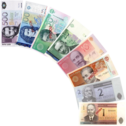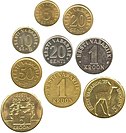| Eesti kroon (Estonian) | |||||
|---|---|---|---|---|---|
| |||||
| ISO 4217 | |||||
| Code | EEK | ||||
| Unit | |||||
| Plural | krooni (Estonian partitive sg.) | ||||
| Symbol | KR | ||||
| Nickname | paper, The family names of the persons on notes: 100 KR – Koidula, 500 KR – Jakobson etc. | ||||
| Denominations | |||||
| Subunit | |||||
| 1⁄100 | sent | ||||
| Plural | |||||
| sent | senti (Estonian partitive sg.) | ||||
| Banknotes | |||||
| Freq. used | 2 KR, 5 KR, 10 KR, 25 KR, 100 KR, 500 KR | ||||
| Rarely used | 1 KR, 50 KR | ||||
| Coins | |||||
| Freq. used | 10, 20, 50 senti, 1 KR | ||||
| Rarely used | 5 senti, 5 KR | ||||
| Demographics | |||||
| Date of introduction | 20 June 1992 | ||||
| Replaced | Soviet rouble (SUR) 10 SUR = 1 EEK | ||||
| Date of withdrawal | 14 January 2011 | ||||
| Replaced by | Euro (EUR) 15.6466 EEK = 1 EUR | ||||
| User(s) | None, previously: | ||||
| Issuance | |||||
| Central bank | Bank of Estonia | ||||
| Website | www | ||||
| Valuation | |||||
| Inflation | 2.8% | ||||
| Source | European Central Bank, May 2010 | ||||
| Method | HICP | ||||
| EU Exchange Rate Mechanism (ERM) | |||||
| Since | 28 June 2004 | ||||
| Fixed rate since | 31 December 1998 | ||||
| Replaced by euro, non cash | 1 January 2011 | ||||
| Replaced by euro, cash | 14 January 2011 | ||||
| 1 € = | 15.6466 KR | ||||
| Band | did not fluctuate[1] | ||||
| This infobox shows the latest status before this currency was rendered obsolete. | |||||
The kroon (sign: KR; code: EEK) was the official currency of Estonia for two periods in history: 1928–1940 and 1992–2011. Between 1 January and 14 January 2011, the kroon circulated together with the euro, after which the euro became the sole legal tender in Estonia.[2][3] The kroon was subdivided into 100 cents (senti; singular sent).
The word kroon (Estonian pronunciation: [ˈkroːn], “crown”) is related to that of the Nordic currencies (such as the Swedish krona and the Danish and Norwegian krone) and derived from the Latin word corona ("crown"). The kroon succeeded the mark in 1928 and was in use until the Soviet invasion in 1940 and Estonia's subsequent incorporation into the Soviet Union when it was replaced by the Soviet ruble. After Estonia regained its independence, the kroon was reintroduced in 1992 and replaced by the euro in 2011.
- ^ General principles of the Estonian monetary system Archived 2012-03-16 at the Wayback Machine, Bank of Estonia
- ^ "Stages of cash changeover". European Central Bank. Retrieved 2010-05-12.
- ^ Ministers offer Estonia entry to eurozone January 1 France24, 8 June 2010

